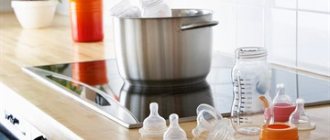Sterilizers: what they are and when you can’t do without them
Sterilizers for baby bottles are a container in which, depending on the design, up to 4 or 8 bottles with different neck diameters are placed.
In addition to its intended purpose, the accessory can be used to clean pacifiers, toys, baby dishes, teethers and breast pumps. The only thing is that all items must withstand heating up to a temperature of 100 degrees.
Depending on the method, the device is placed in an antiseptic chemical solution or ultraviolet light (so-called cold sterilization) or exposed to steam (hot treatment).
Sterilizers will become a real salvation if:
- The child has been bottle-fed since birth. Especially outside the home (while visiting, traveling to the hospital), you should carefully monitor hygiene.
- Newly purchased items need to be cleaned.
- The baby was born prematurely, was recently ill and has a weakened immune system.
How to sterilize bottles in the microwave
There are several ways to sterilize bottles in a microwave oven. Which one to choose depends on personal convenience and the presence or absence of special devices at hand.
How to sterilize bottles in the microwave without a sterilizer
The easiest way to sterilize children's dishes in the microwave is to use a commercial disinfection container. But if it is not available, you can use a regular plastic box. The oven sterilization algorithm looks like this:
- To carry out the procedure, select the most capacious and deep container for heating food.
- Wash the box thoroughly with baking soda or baby dish soap and rinse.
- Wipe the container on all sides with a clean soft cloth.
- Place one or more feeding containers on the bottom, depending on the size of the container.
- Fill the bottles to the top with cold water.
- Close the container with a lid and place it in the oven for sterilization.
- Set the device to maximum power and start the microwave for 1.5 minutes.
- After the sound signal, wait another 2-3 minutes so that the dishes can cool down a little.
- Remove the container from the microwave and wipe with a dry cloth to remove any remaining moisture.
Advice! It is better to sterilize immediately before feeding in order to use the cleanest possible utensils.
Only whole bottles can be sterilized in a microwave oven - containers with chips and cracks must be replaced
Sterilization in special packages
If you don’t have deep plastic containers on hand, you can sterilize feeding bottles in the microwave in special bags. Disinfection is carried out according to the following scheme:
- Wash the children's dishes from dirt and wipe them from moisture.
- Place it in a bag and let the air out a little.
- Pour hot water inside, and then fasten the device and check for leaks.
- Place the bag in a deep microwave-safe glass plate.
- Place the container in the chamber of the device.
- Set the settings required for sterilization in accordance with the instructions on the bags themselves.
- After the signal about the end of the microwave oven, remove the plate.
- Allow the bags to cool slightly and drain the hot water from them through a special spout or a slightly open clasp.
Bottles that have been sterilized in the microwave must be wiped to remove any remaining liquid. If there is still some time left before feeding, the container should be placed in the refrigerator on a specially prepared clean shelf.
Baby bottles in bags are especially convenient to sterilize in an oven outside the home - at a party or in a hospital
How to disinfect bottles using a sterilizer
The sterilizer is a container with several cells for bottles and a sealed lid. It is convenient to use the device because it is designed specifically for processing children's utensils. Disinfection is carried out as follows:
- Wash both the sterilizer itself and the bottles with a safe hypoallergenic product, rinse thoroughly and wipe dry.
- Place feeding containers in the compartments and pour water into the bottom of the device.
- Close the lid of the sterilizer and place it in the microwave oven.
- In accordance with the instructions, set the required power and time interval.
- Start the microwave oven and wait for the sound signal.
- Remove the sterilizer from the device chamber and allow it to cool slightly at room temperature.
- Take baby dishes out of the cells, wipe them from moisture and put them in a clean place or immediately use them for feeding.
Attention! It usually takes 6-8 minutes to sterilize bottles and nipples in the microwave at 800 W microwave power.
Feeding bottles are placed with their spouts down in a special sterilizer.
How to handle self-sterilizing bottles
It is most convenient to process special containers with a self-sterilization function in a microwave oven. To disinfect them, no additional containers or plates are required. The disinfection process looks like this:
- Children's utensils are first washed under the tap to remove major contaminants and rinsed thoroughly.
- A little water is poured into a special upper nozzle.
- Insert the lid and nipple with the attached handle, and then connect the main container and snap tightly.
- Place the bottle in the microwave oven and set the settings in the settings specified by the manufacturer of the self-sterilizing utensil.
- Upon completion of the microwave operation, remove the dishes, drain the water and use the container for its intended purpose.
Typically, it only takes about 90 seconds to sanitize a self-sterilizing bottle in a microwave oven at maximum power.
Self-sterilizing containers are designed for frequent high-temperature processing and are not prone to deformation
Electrical
Such models contain a housing, a heating element and a water tank. The device is connected to a 220V network, the water is heated, and the bottles are treated with steam.
Additional options include a timer, several sterilization modes, automatic shutdown and a digital screen. If you keep the lid closed at the end of the process, the items will remain sterile for another 3-6 hours.
Instructions for using electric sterilizers:
- Pour a small volume of water into the special compartment - 200 ml (the exact value must be clarified in the device passport).
- Place the required number of jars with the bottom up, and place lids or nipples in the remaining space.
- Close the lid and turn on the machine.
Microwave devices
Simpler and cheaper are devices for microwave ovens. This is a set of a bowl into which water is poured and bottles are placed. A lid is placed on top, and the sterilizer is placed in the microwave for 10 minutes. On sale you can find special thermal bags for sterilization, which are placed in an oven like a bowl.
In both cases, the effect will only occur when steam treatment occurs. If bottles are placed in a microwave oven without a sterilizer, disinfection will not occur.
Sterilization in a multicooker: features
Many manufacturers of multicookers began to make models with a special function - sterilization. It can be either steam or water. But regardless of the chosen method, the process goes very quickly and efficiently. The dishes are clean, there are no water residues, various drips or stains on them, which indicates that the method is very good. But even if there is an old-style multicooker in the kitchen, sterilization can be carried out without any effort or purchasing additional equipment.
Processing bottles in a slow cooker
So, there are two options for how to sterilize jars in a regular multicooker, which does not have a special function. To do this you will need:
- a special bowl is a mandatory component of any model;
- device for steaming food.
So, a bowl is installed in which the food is prepared. The container must be thoroughly washed to remove any remaining food. It is better to use a special detergent that allows you to wash children's dishes. About one liter of ordinary water is poured into the bowl, it can be warm or even hot - this way the device will quickly reach the desired temperature, which, accordingly, will save electricity. A liter of liquid will be enough to create good vapor. To avoid water stains, it is better to use purified water. This can be a purchased liquid or one that has been purified at home using a filter. Then a steamer is placed on top, and jars and lids are placed on top of it, neck down. The lid with the nipple can also be placed next to it. And a special program is activated, which is used, for example, for steaming cutlets.
Sterilization in a multicooker
Features: Some multicookers have a very shallow steamer, and some baby bottles may not allow you to close the lid. In this case, they can be put down. This will not change the quality of sterilization, but the process will go much faster. As the water boils, steam will begin to rise, filling the bottles and lids. The process lasts approximately 15-20 minutes from the moment it is turned on.
Another method of sterilization in a multicooker is somewhat similar to the old method: you also need to thoroughly wash the container and pour purified water into it, and then put the bottles there. Any program that provides heating up to 100 degrees can be installed. Bottles boil for about 15-20 minutes, but usually no longer than half an hour, depending on the power of the multicooker.
This method is convenient because you can put a larger number of bottles and nipples than in the first option. However, the second option takes longer.
Processing children's dishes
Heated
An interesting solution is sterilizers for heated bottles. Most often, it is designed for one bottle. In addition to getting rid of germs, the device allows you to heat formula or milk to a temperature that is comfortable for the child. Some devices operate from a car cigarette lighter, which is very convenient when traveling with a child.
Choosing the right one
Which bottle sterilizer is better: steam or electric? The answer depends on the frequency and conditions of its use.
- Massage with a dry brush (drybrushing) - how to do it correctly, contraindications
The best bicycle models
Glucometer - review of the best devices of 2021. How to choose a device and useful information on setting it up
Among the advantages of electric sterilizers are large volume, ease of use and the presence of built-in programs. If the high cost, periodic descaling and some bulkiness do not scare you, then you can safely purchase such a thing.
Microwave devices are more affordable, convenient to store and maintain. But they are designed only for those children's dishes and utensils that can be placed in the microwave.
Sterilization methods
In modern conditions, various options for sterilizing children's utensils are available. The usual method - boiling bottles - has long faded into the background. This is not to say that it is inconvenient or has many negative aspects. But with the advent of modern technology, many housewives are trying to get around it, replacing it with other more convenient and improved techniques. Even though there are special sterilizers for children's dishes on the market.
The most common methods:
- Sterilization in a double boiler is a fairly quick and convenient option. To do this, you need to pour water into the appropriate container, as written in the instructions, and place the baby dishes in the upper compartment with the neck down. You need to turn on the device for literally 10-15 minutes. Then remove the clean dishes.
- In a microwave, sterilization is somewhat more complicated. To do this, you need to prepare special dishes that can withstand high temperatures, in addition, they must be clean. To sterilize dishes, place them in containers or bags, fill them with water and cover with a lid. The time that the dishes should be inside depends on the quality and power of the device. On average it is 5-7 minutes.
How to sterilize in the microwave - In a slow cooker, this process is not only faster, but also better. To do this, you can use a special program that will allow you to thoroughly sterilize not only glass, but also plastic bottles.
Sterilization process in a multicooker - In special sterilizers this process takes place efficiently. There is a huge variety of such devices available on the market. They all have a basic positive and negative point. The advantage is that children's dishes that undergo this treatment will be sterile for several hours. The downside is the high cost of the devices.
But despite such a variety of sterilization methods, many prefer processing in a slow cooker. This device is found in almost every kitchen, and in addition, it will carry out this process efficiently.
Some tips for choosing sterilizers from the pros
The capacity of microwave sterilizers is larger than that of electric ones. Therefore, it makes sense to take them when several jars need to be processed at once.
All surfaces of the device, especially its working area, must be made of environmentally friendly materials. And safety must be confirmed by a quality certificate.
It is better to purchase devices from well-known and well-established brands. Among the best manufacturers of bottle sterilizers are: Philips/Avent (the line includes electric and steam devices for microwaves), Tefal Baby Home, Maman LS-B302.
Air purifier - rating of the best household ionizers of 2021. Tips for installation and choosing a location for installationElectric toothbrush: how to choose a reliable model and review of the parameters of the best brushes of 2021
- Ultrasonic toothbrush: rating of 2021 and the best models. Pros, cons and tips for choosing








